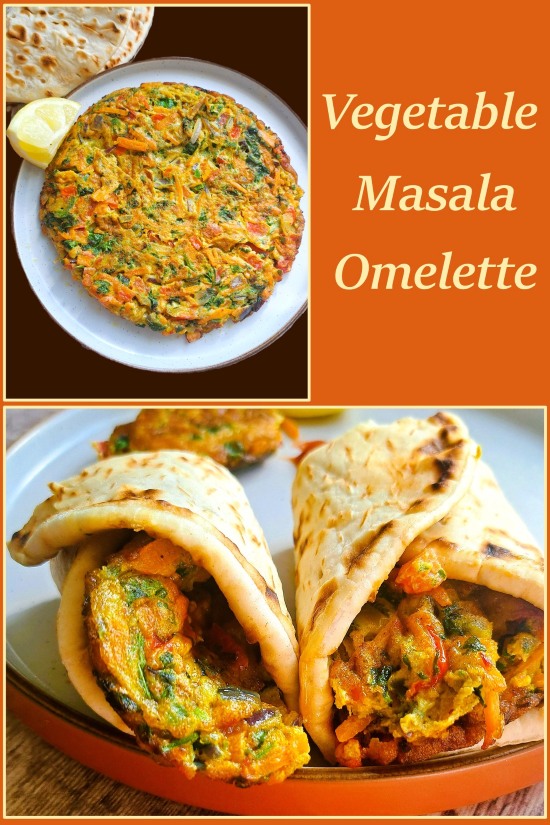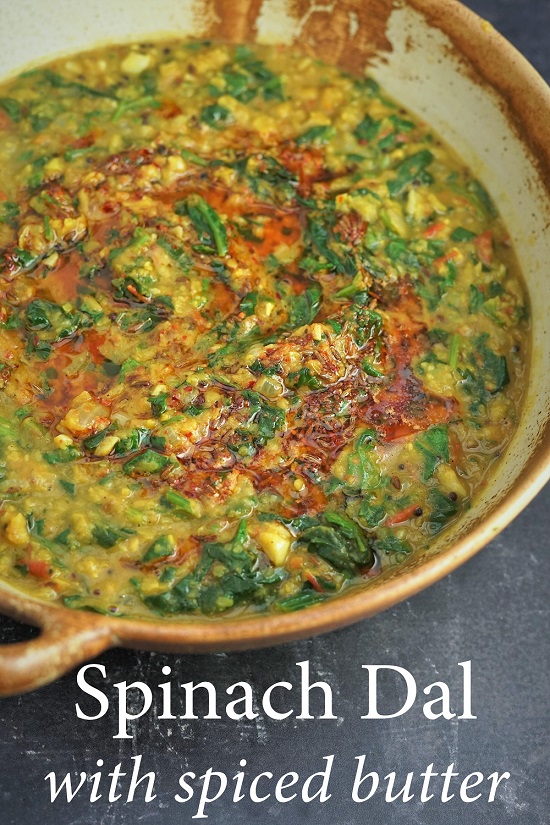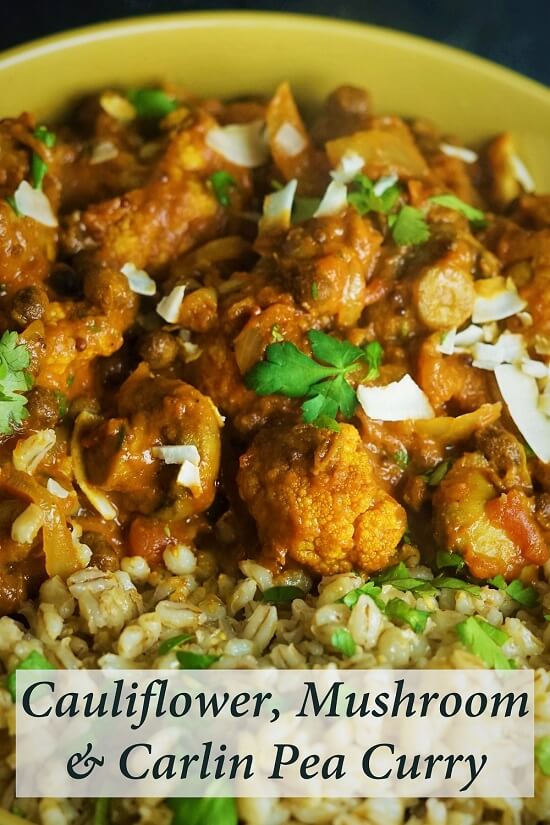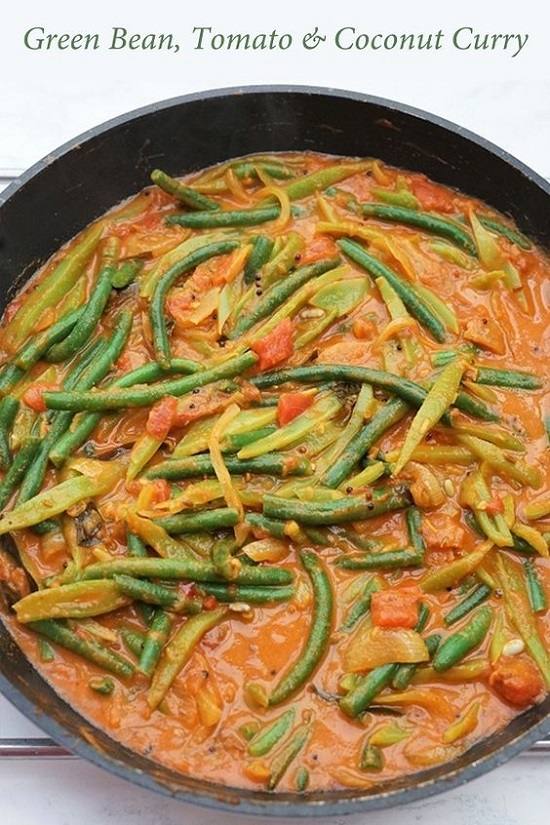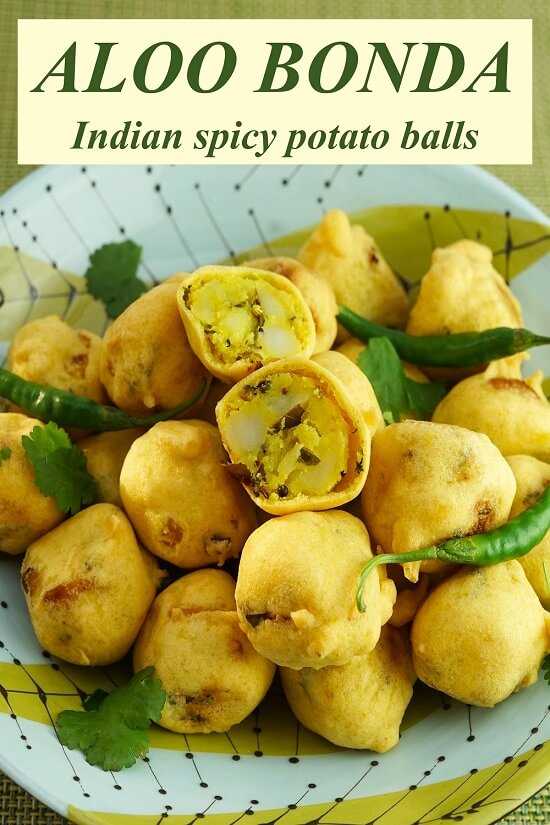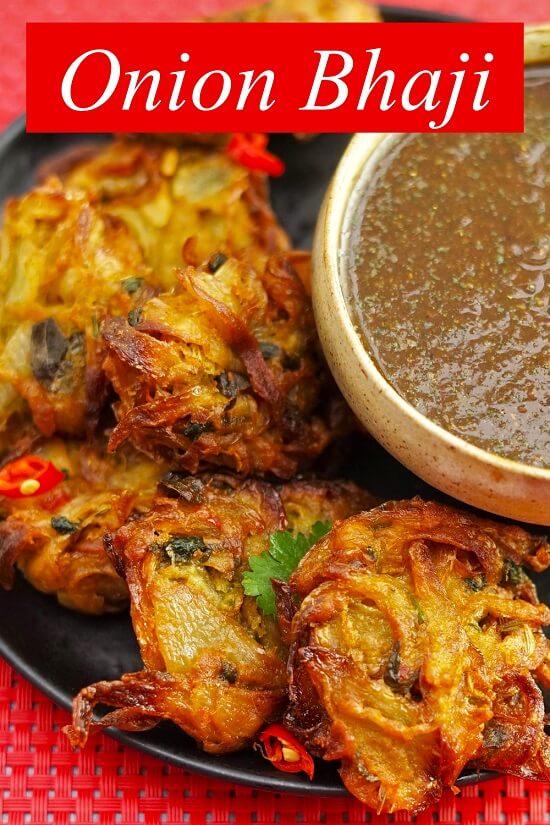Chickpea, Potato & Coconut Curry
Chickpea, Potato & Coconut Curry is subtly spiced but delicious. Chickpeas and potatoes in a coconut-yogurt sauce flavoured with earthy spices like cumin, coriander, mustard, turmeric, and fennel seed. Not your average chickpea and potato curry, here chunks of crispy roasted potato are stirred in just before serving.
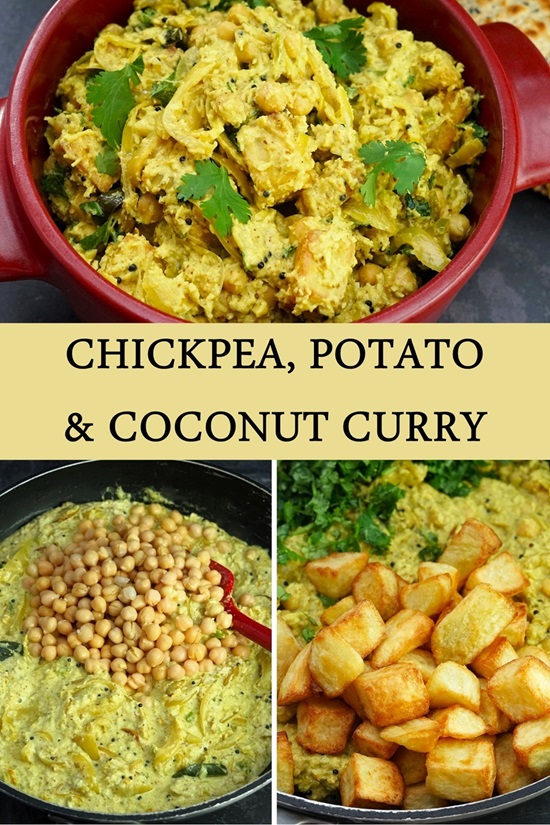
Jump to Recipe
I’m so excited to share with you my recipe for Chickpea, Potato & Coconut Curry. It’s one of those dishes that, although it does sound good on paper, in the eating it’s really good! Nutty chickpeas are one of my favourite pulses and, like many Brits I’d guess, I love my potatoes. Add to that another of my favourite things – coconut – and it’s not surprising I like it. But it’s the combination of spices that really hit the spot for me. With cumin, coriander, and fennel seed, toasted with cashews or almonds, plus mustard seeds and turmeric, the flavour is quite earthy.

The spice mix is combined with yogurt and desiccated coconut to create a subtle-tasting sauce. Cook that with a base of softened onions, garlic, ginger, and green chillies, finish it with chickpeas and crispy potatoes and you have a complexly flavoured, satisfying curry that’s rather delicious!
I like to make this curry a dryish rather than saucy one. But, as we’ll see, you can easily adapt it to your own preferences.
CHICKPEA, POTATO & COCONUT CURRY
My Chickpea, Potato & Coconut Curry is based on a dish in The Art of Indian Vegetarian Cooking (Leopard, 1995). It’s a huge book of around 800 pages and well worth hunting out. Be aware though that author Yamuna Devi (not her given name) isn’t Indian but American and the book is aimed at Western cooks rather than reproducing ‘authentic’ Indian cooking
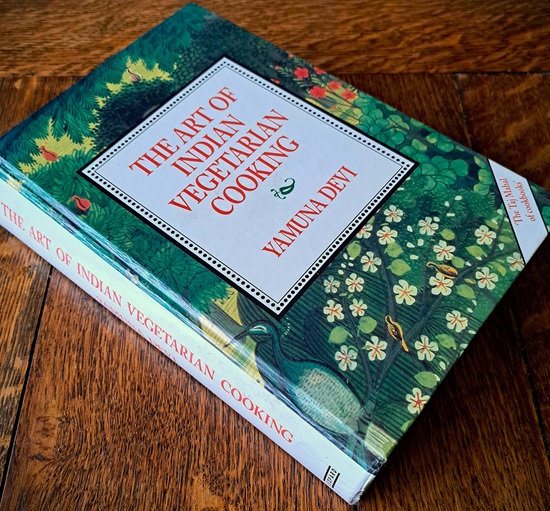
As personal cook to a swami or Hindu religious leader, her recipes follow the interpretation of Ayurveda that says yogis shouldn’t eat garlic or onions. This means you won’t find either in her book. But I love them in most curries, so plenty of onion and garlic is one of the main differences in my version.
Another distinction is that instead of the deep-fried potatoes in the original, for my Chickpea, Potato & Coconut Curry I cook them in an air fryer. So much quicker and with less oil, they’re light and deliciously crunchy.
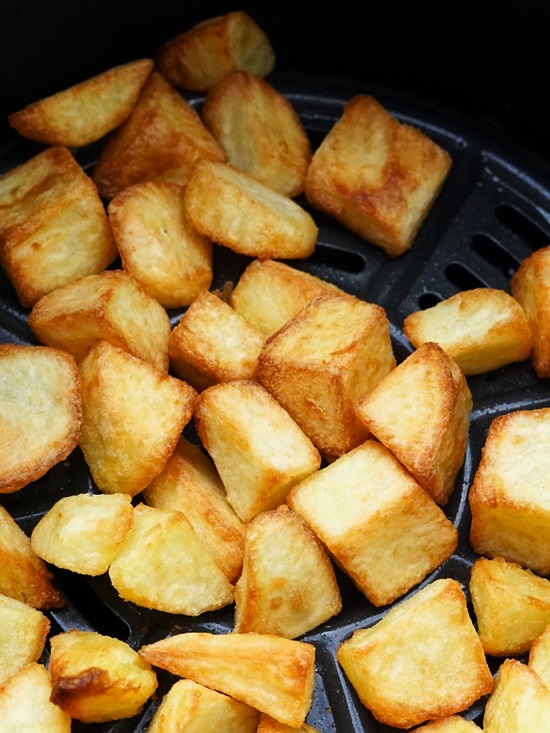
If you don’t have an air fryer, you can roast the potatoes in the oven. They’re added at the last minute, so they keep their crispness. But I think the browned outer layer adds so much flavour and pleasure even if the curry’s sat a while and they’ve gone a little soft. I always enjoy leftovers the next day when the earthy spicing seems to taste even better!
You’ll find detailed instructions and ingredient amounts in the recipe card at the end. But I suggest you read on for an overview of the method plus tips, alternative ingredients, and step-by-step images.
MAKING CHICKPEA, POTATO & COCONUT CURRY
This lovely curry is easy to make, especially if you break it down into a few simple steps.
1. MAKE THE SPICED COCONUT-YOGURT SAUCE
We start by toasting the whole spices and nuts to bring out their flavour. I’ve used equal amounts of coriander, cumin, and fennel seeds plus some black peppercorns. For the nuts, I love the creaminess of cashews, but almonds would work too. After dry frying in a hot pan, I whizz them in a coffee/spice grinder until they’re a fine powder. If you don’t have a grinder, you could use a pestle and mortar.
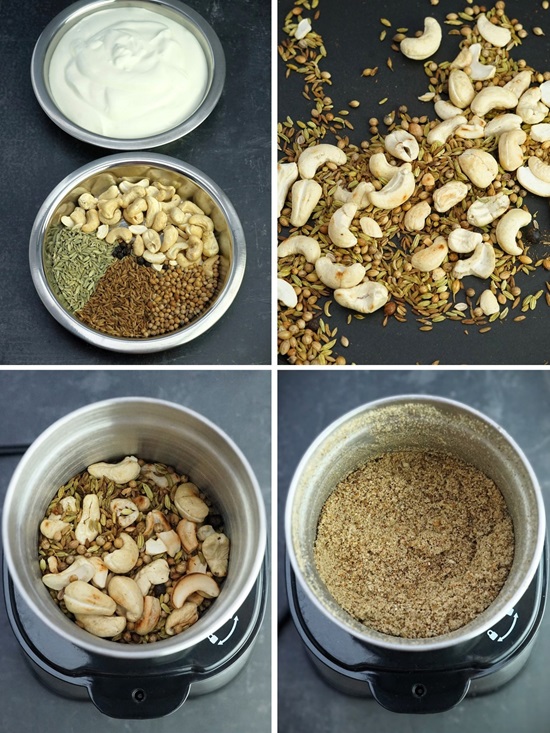
The spice mix, which will already smell gorgeous, then joins yogurt, desiccated coconut, plus a little water in a blender. Whizz them together until smooth then set aside.
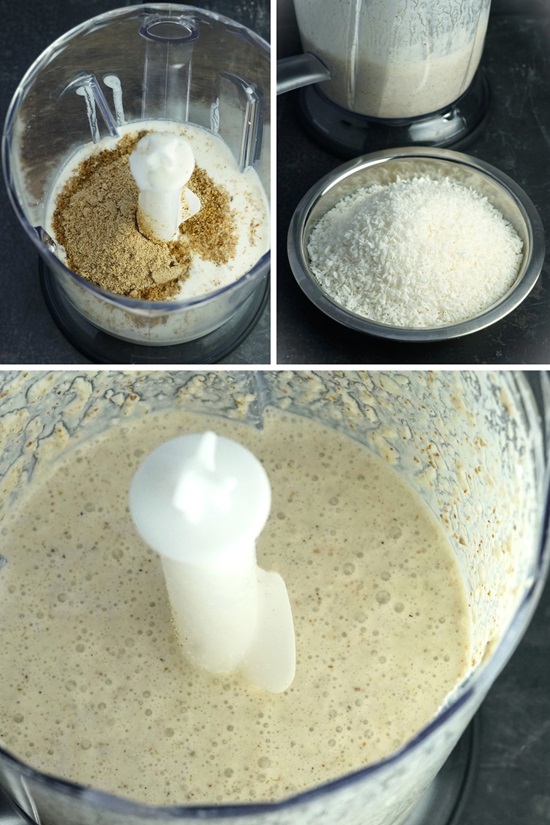
2. GATHER INGREDIENTS FOR THE CURRY BASE
To make the base of the Chickpea, Potato & Coconut Curry you’ll need:
- Coconut oil. This is used to soften the aromatics, onion etc. If you don’t have coconut oil, then another can be substituted. Or you could use ghee.
- Black mustard seeds. Fried in the oil, these add to the earthy flavour.
- Onion. You’ll need a large one, cut in half and thinly sliced.
- Garlic. I use 6 large cloves, finely chopped.
- Green chillies. I prefer a medium heat so use 2 minus their seeds.
- Ginger root. I store mine in the freezer where it keeps for months. Scrape away the skin from about 3 cm then finely grate or chop.
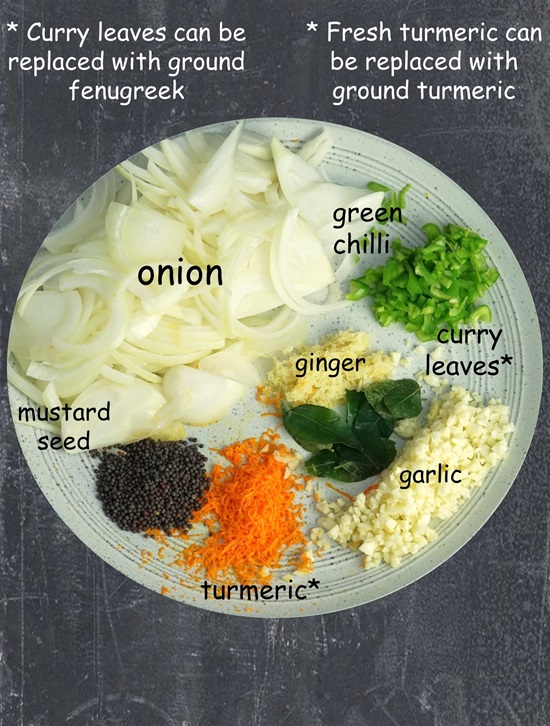
There are two ingredients pictured that are not so easy to come by as the others. They’re well worth seeking out though, so I’ll just say a bit more about them as well as suggesting alternatives.
- Fresh turmeric. Turmeric root is a lovely addition to this recipe. Much less bitter than dried ground turmeric, you can store and use it just like ginger. I got mine as an add-on to my veg box delivery although you can find it online. I’ve successfully made this curry with regular ground turmeric though and have given instructions for both in the recipe card.
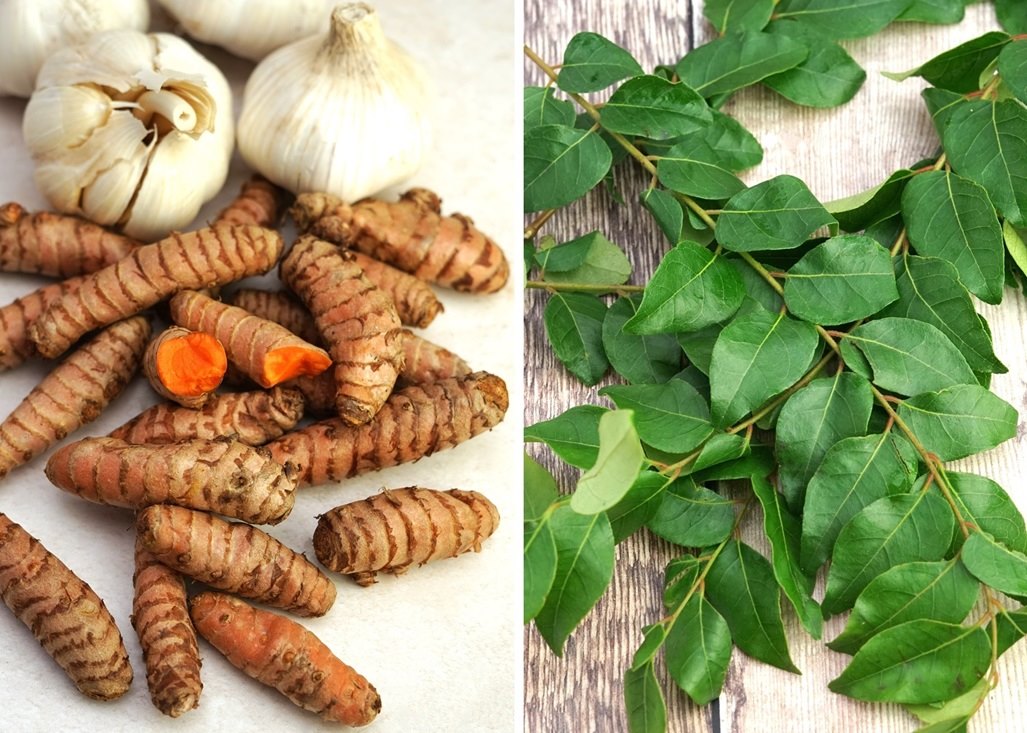
- Curry leaves. Fresh (not dried) curry leaves add a very special flavour and aroma that’s hard to describe. There’s nowhere locally I can get them, so I buy online and freeze. If you don’t have curry leaves then you can add a teaspoon of ground fenugreek. This won’t taste the same, but it does bring a little more complex flavour.
3. COOK THE CURRY BASE
To make the curry base, we start by sizzling black mustard seeds in hot coconut oil until they fizzle and turn light grey. Then, over medium heat we add the onion and cook until it’s quite limp and starting to brown. This takes 12 – 15 minutes and we add the garlic, chillies, and ginger (plus the fresh turmeric if using) for the final 5 minutes. Tip: while this is happening, it’s a good idea to start the potatoes.
If you have curry leaves, these go in next, followed by the spiced coconut-yogurt sauce, a little salt, plus the ground turmeric and fenugreek if you’re using those. Once we’ve brought it to a boil, a tin of drained chickpeas goes in. Now you turn the heat to low and let everything simmer.
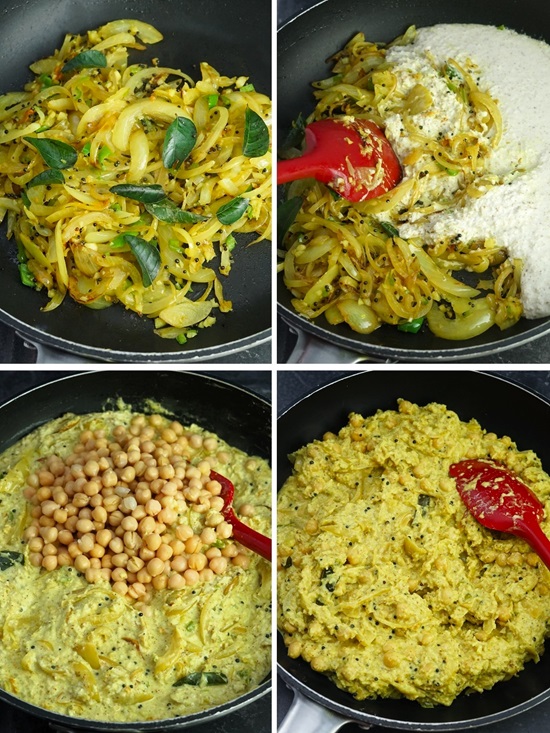
What we’re aiming for is a reduced sauce with any harshness from the spices cooked out. This should take 15 – 20 minutes. Stir often to prevent sticking and, if the curry looks dry before the spices are done, stir in a little water. As mentioned, I prefer this curry to be a dryish one. However, you can add more water if you want it saucier, or even some coconut milk for a richer, creamier curry.
FINISHING & SERVING CHICKPEA, POTATO & COCONUT CURRY
If you started the potatoes while the onions were cooking, they should easily be ready by the time the curry’s done. I simmer bite-sized cubes of potato in salted water until only just tender. Well drained and tossed with a little olive oil and salt, they take 15 – 20 minutes in my air fryer preheated to 200 C. In the oven, they’ll be 5 – 10 minutes longer.

Before adding the crispy potatoes, taste the curry and add extra salt if needed. Be sure to have any other elements of the meal ready to go too. Finally, gently toss the potato chunks through the curry along with some chopped coriander.

To serve, add wedges of lemon for everyone to squeeze over for its fresh acidity. I like an extra sprinkle of fresh coriander leaf too.
I love to serve Chickpea, Potato & Coconut Curry with flatbreads and salad. Here you see a variation of my quick and easy Yogurt Flatbreads where I simply added to the dough 2 teaspoons each of nigella seeds and garlic powder. Alongside I like a crunchy vegetable salad too, sometimes with mustard and cumin seeds sizzled in oil and poured over.
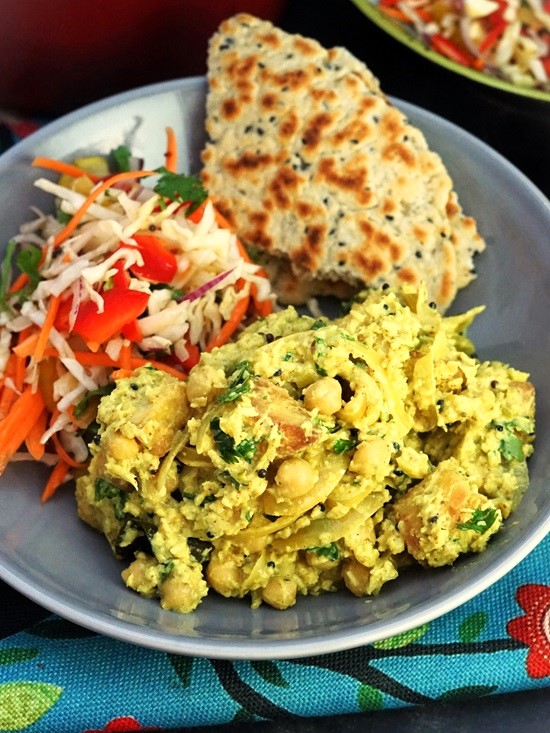
Although the potatoes won’t be crispy the next day, leftovers really are very good. Add a little more water and gently reheat in a saucepan or in the microwave. Like so many curries, you’ll find that the spices and aromatics have melded further, making it even more enjoyable.
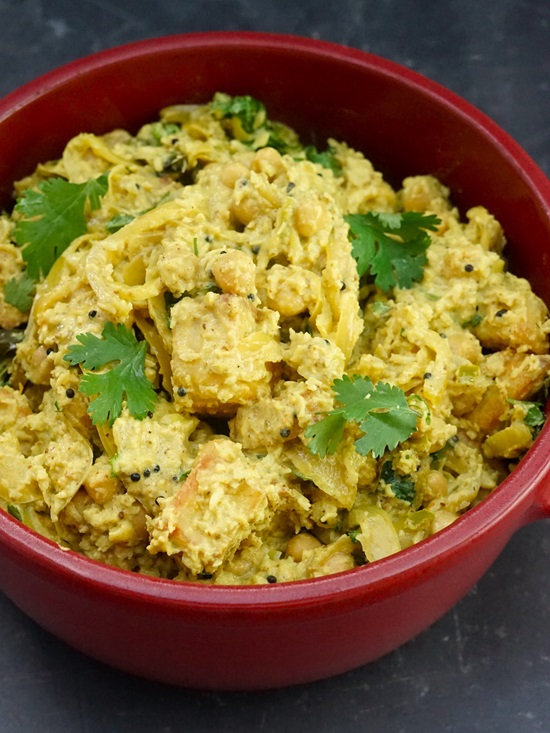
Obviously, the potatoes will be completely soft rather than crunchy now. But they’ll still have extra flavour from being browned AND they’ll have absorbed lots of that warmly spicy coconut flavour.
I hope you love this simple but delicious curry as much as I do. If you’ve made it, please leave a comment and rating.
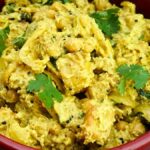
Chickpea, Potato and Coconut Curry
Subtly spiced but delicious, this simple curry has chickpeas and roasted potatoes in a coconut-yogurt sauce flavoured with earthy spices like cumin, coriander, mustard, turmeric, and fennel seed.
Add the roasted potatoes just before serving to keep them crunchy, but leftovers will still taste good even when the potatoes have softened.
Lovely served with flatbreads and a crunchy vegetable salad.
Ingredients
For the spiced coconut-yogurt sauce
- 30 g cashews (blanched almonds can be substituted)
- 2 tsp coriander seed
- 2 tsp cumin seed
- 2 tsp fennel seed
- 8 black peppercorns
- 250 ml whole milk yogurt
- 125 - 250 ml water see Recipe Note 1
- 90 g desiccated coconut
For the potatoes
- 500 g potatoes peeled and cut into bite-sized chunks (weight is before preparation)
- salt to taste
- olive or other oil for air frying or roasting
For the curry base and serving
- 2 tbsp coconut oil or other oil or ghee
- 2 tsp black mustard seeds
- 1 large onion halved and thinly sliced
- 6 cloves garlic finely chopped
- 1 - 2 green chillies deseeded if liked, chopped or thinly sliced
- 3 cm ginger root grated or finely chopped
- 3 cm turmeric root or 1 tsp ground turmeric: see Recipe Note 2
- 8 fresh curry leaves or 1 tsp ground fenugreek: see Recipe Note 3
- salt to taste
- 240 g cooked, drained chickpeas approx. 1 standard can after draining
- 1 small bunch coriander roughly chopped
- lemon wedges to serve
Instructions
Make the spiced coconut-yogurt sauce
-
Put the nuts and spices in a frying pan over medium heat. Toast, stirring all the time, until the nuts are browned and the spices are giving off their aroma.
Transfer to a blender or coffee grinder (or use a pestle and mortar) and grind to a fine powder.
Put the yogurt, 125ml of the water, the desiccated coconut, and the spice powder in a blender, whizz until smooth then set aside.
Make the curry base
-
Put the coconut oil in a large frying or sauté pan over high heat.
When hot, stir in the mustard seeds and fry until they pop and turn a grey colour.
Turn down the heat to medium-low then stir in the sliced onion. Cook until the onion is quite limp and starting to brown (12 - 15 min), adding the garlic, chillies and ginger, plus fresh turmeric if using, for the final 5 minutes.
Tip: you can start cooking the potatoes while the onions are softening.
Increase the heat to high and add the curry leaves if using. Stir for a few seconds then add the spiced coconut-yogurt sauce, ¾ tsp of salt, plus the ground turmeric and/or ground fenugreek if using.
When the sauce comes to a boil, add the chickpeas, then reduce the heat to low.
Cook, stirring often to prevent sticking, until the sauce is reduced and the raw flavour is cooked out of the spices (15 - 20 min). If it looks dry before the spices are cooked, or you'd prefer a looser texture, stir in extra water.
When done to your liking, taste and add extra salt if necessary.
Roast the potatoes (start while the curry base is cooking)
-
Put the potato chunks in a saucepan of salted cold water. Bring to the boil and simmer until almost tender.
Drain well, transfer to a bowl, then toss with the olive oil plus a little extra salt.
To air fry
Preheat your air fryer at 200°C for 3 minutes. Add the potatoes and cook for 15 - 20 minutes or until crispy and done to your liking. Shake often for even browning.
Roast in the oven
Preheat your oven to 230°C / 210° Fan / Gas 8 / 450 F with a baking tray inside. Tip the potatoes into the hot tray and roast, turning often, until crispy and done to your liking (approx. 20 - 25 min).
Keep hot or time them so they're done at the same the curry base.
Finishing the curry and serving
-
When the curry is ready, stir in the hot potatoes and most of the coriander.
Serve sprinkled with the remaining coriander plus lemon wedges to squeeze over.
Recommended accompaniments: Yogurt Flatbreads add 2 tsp each of nigella seeds and garlic powder to the flour when making the dough. Crunchy shredded raw vegetable salad (cabbage, carrot, onion, peppers etc.) dressed with cumin and mustard seeds sizzled in hot oil.
Recipe Notes
Note 1: Amount of water plus alternative.
The lower amount of water shown in the ingredients will result in a dryish curry which I prefer. However, you can add more for a looser result. Additionally, for a richer, creamier curry, stir in 4 or more tablespoons of tinned coconut milk at the same time as the chickpeas.
Note 2: Turmeric.
Fresh turmeric, which looks similar to ginger root, is subtly spicy and less bitter than ground turmeric. Also like ginger, it will keep for months in the freezer. If you can't buy it locally then look online. Alternatively, substitute with 1 level tsp of ground turmeric and add it with the spiced coconut-yogurt sauce.
Note 3: Curry leaves.
Fresh curry leaves (dried aren't recommended) add a very special flavour and aroma that’s hard to describe. If you can't buy them locally then look online. Leaves freeze very well. If you don’t have curry leaves then you can add a teaspoon of ground fenugreek with the spiced coconut-yogurt sauce. This won’t taste the same, but it does bring a little more complex flavour.
Recipe based on one by Yamuna Devi in The Art of Indian Vegetarian Cooking (Leopard, 1995).
RELATED RECIPES

